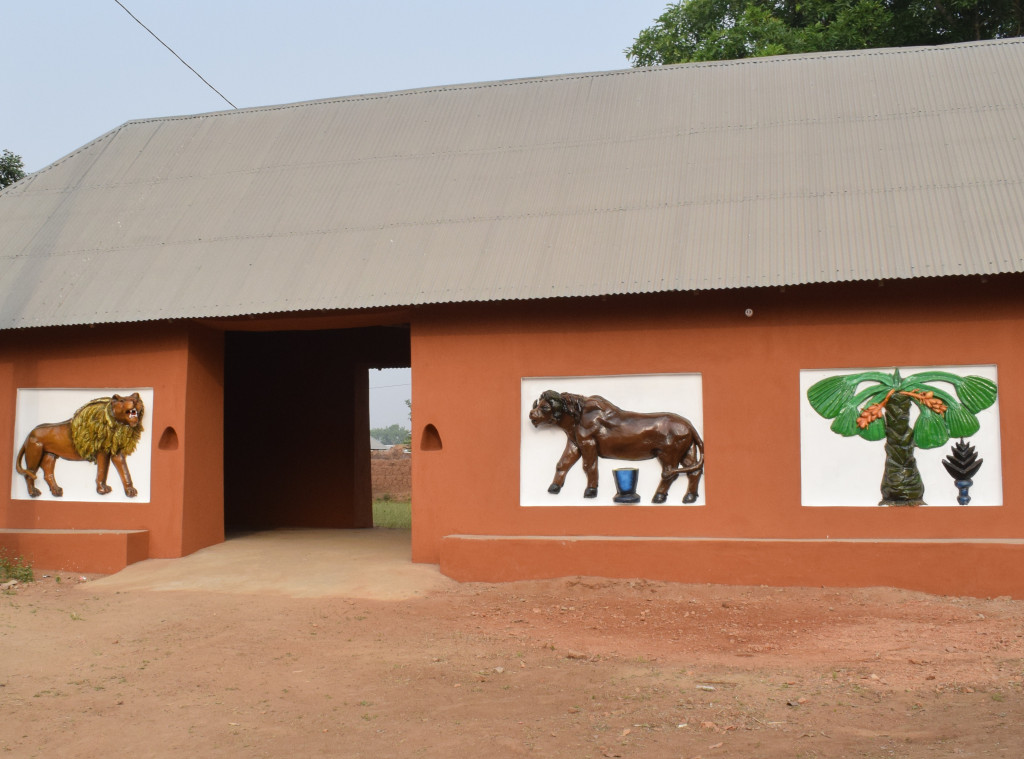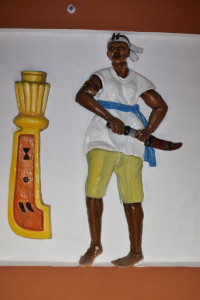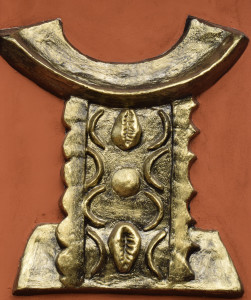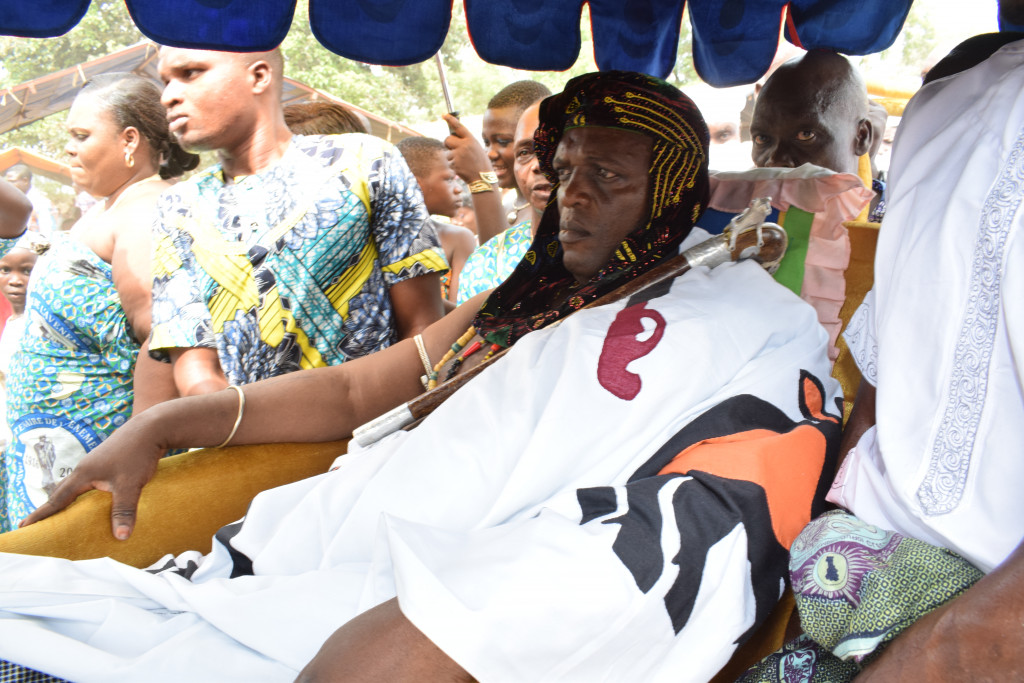Cana, a neglected piece of Black History

BY USMAN MAMA
PHOTOGRAPHY BY ARSENE KASSEGNE
Cana, today a regular village with a population of ten thousand people located on both sides of the Benin-Niger interstate highway 87 miles from Cotonou (Benin’s largest city), is a prime historical landmark of the West African former French colony known as Dahomey before changing its name to Benin in 1975. Cana was, indeed, the last settlement of the Aladaxonu people who migrated from Tado—in present-day Togo—prior to their founding, further away on the higher land of Agbomê, of the mighty and prosperous kingdom of Danxomê which heroically fought the French army from 1890 to 1894 in its attempt to avoid being colonized. “If Agbomê is the center of political decision-making, the administrative backbone, Cana is the religious heart of Danxomê where the monarchs come home to their roots, warm their heart, clear their mind and fortify their soul,” writes Jérôme C. Alladayê, a History professor at the National University of Benin in a 1993 essay titled “Cana, the Holy City of Danxomê.”
Prior to the French invasion of what later became the French territory of Dahomey in 1894, the kingdom of Danxomê (wrongly called Dahomey by the colonial power who didn’t know better) was the dominant military, political and economic power in most of the space, with Agbomê (not Abomey) as its capital.

Writing about pre-colonial Danxomê in an article published in the December 19, 2016 issue of one of Benin’s daily newspapers, La Nation, David Koffi Aza, an articulate Benin intellectual, stated: “The colonizers came to Africa to copy us. For instance, the Danxomê army was the first one in the world to have females in its midst. Also, it was in 1970 that Yves Saint Laurent [a renowned French fashion designer] made women wear pants for the first time in France. Whereas our women had been wearing ‘Tchanka,’ that is known today as pants, since 1600.” Aza also noted that “It was not until the French Revolution that the notion of secret service came to life in the West. But the [Danxomê] royal dynasty had been using secret service agents as early as 1600.” He added: “These agents were predominantly females recruited among the most beautiful ones in the kingdom, and were sent on mission in the neighboring kingdoms to be conquered.” Their mission was to seduce the local dignitaries at the highest level, and use their presence to develop the map of the kingdom and send it back home.
And Cana was one of the three strategic components of this prestigious kingdom, the other two being Agbomê itself, the politico/administrative capital, and the Port of Glexwé—Ouidah in French.
Genesis
Oral tradition has it that the name Cana derived from Kan-Minan, a name given by a group of migrants from present-day Nigeria who felt that the area looked very much like a region in Nigeria called Kan-Minan. Warmly received by the Gédévi, the local population of hunters and subsistence farmers of corn, millet and beans, the newly-arrived mingled smoothly with their hosts. This paved the way for marriages among members of the two groups, leading to the advent of a diverse society that was well served by the Yoruba migrants’ know-how in trade.
Cana welcomes the future
founders of Danxomê
Cana later experienced the arrival of a new group of migrants from within what will later become the French territory of Dahomey: that of the Aladaxonu. Having left Tado, in present-day Togo (west of present-day Benin) following a succession dispute, the descendants of King Agasu founded in 1600 the Kingdom of Alada under the leadership of their elder, Ajahuto, with Togoudo as their capital. But the group split up again as a result of yet another succession dispute. So, Ganyehesu, Zanvo, Zonlo and Djegbo, all children of Dogbagri, followed their brother Dako northward in search of a new home. In the process, Cana became one of the main stops in their journey toward what later became Agbomê, the much-feared kingdom that resisted French colonization for years.

of the Danxome King
The hospitable Gédévi people lived up to their reputation. Local landowners including Aïnon Kpahé and Wo (in the west) and Aguidi (in the south-east) gave the Aladaxonu plots of their lands.
Professor Alladayê writes that History noted few fights between the newly-arrived Aladaxonu, who had a reputation of cunning war mongers, and the local Gédévi and Yorubas, except the fight for Cana Tota, in the spot that later became the Mignonhi market. Thanks primarily to marriages between members of the various groups, the community developed into a harmonious one.
But the Gédévi, with their fast-growing population and their reputation (noted by History) for being extremely well-organised—they soon became virtually the owners of the place—started to worry the Gédévi landowners. One of the latter, Wo, sent them further north, near Gbaguidi, one of the local chiefs. That signaled a new departure for the migrating Alaxadonu. But not for all of them.
Cana, the Holy City of Danxomê
Even some of the Aladaxonu who left did remain attached to Cana, the hospitable place that proved a crucial stop in their long exodus that climaxed into the founding of the powerful Danxomê kingdom. Professor Jérôme Alladayê writes:
“The buried dead, the protective gods for which sanctuaries have been built, all contribute to making Kana a place of deep significance for the Aladaxonu history and culture, a place where the founders of Danxomê and their descendants are mindful of the need and duty to come and periodically immerse in the regenerative grace of the protective spirits.”
The Benin scholar adds:
“Learning from the bad experience of Ganyehesu who, after going back to Alada to enherit the throne of his father Dogbagri, lost the throne to his younger brother Dako, the successive kings of Danxomê will choose Kana as the place of the definitive ointment for every new monarch. Thus Kana earned the status of a holy place inhabited by the protective gods and ancestors.”
Cana’s status as a holy city was boosted by King Agadja who built his palace at Cana Tota in 1708. From his reign and on, every new monarch enthroned at the main palace in Agbomê was required to erect a secondary palace at Cana, a requirement met by all the kings, except Gbêhanzin and Agoli-Agbo whose special circumstances stemming from the French conquest of Danxomê are well known.

The shield of great voodoos
Cana also derived its prestige from the establishment of the dynasty’s great protective voodoos there, some of which the kings brought home from war fronts (like other war trophies such as the enemies’ music and dances, or their most beautiful women.) Voodoos brought home and established in Cana by the dynasty included, among others, Tegbesu bringing the hèvioso Adantohou from Angonli and the tohuo Sidigbo from Alada, or Gezo establishing his hèvioso Klémèloko, or his son Glèlè installing his favourite wife’s tohuo Adanloko. Hisorians stress the fervent worship the Danxomê kings devoted to these voodoos, just as they did for their individual Ajahuto voodoo established in Cana to honor the memory of their ancestor Ajahuto who led the initial group that migrated from Tado and founded the Alada kingdom.
The French colonizer, who was all-too aware of the significance of Cana as a sanctuary, made sure he first destroyed it before his assault on Agbomê. The army of Gbêhanzin, the last pre-colonial king of the dynasty, put up a tenacious fight, losing up to 4,000 soldiers in the defence of Cana alone.

Once a glamorous spot in the history of Danxomê, a kingdom spreading majestically from its capital Agbomê all the way to the port of Glexwé, that derived its wealth from the slave trade and its military power, thereby earning respect from several others—including the rich Oyo kingdom in Nigeria from which King Gezo freed his kingdom—Cana lost its magic and became just one of several administrative units erected by the colonial administration on the ruins of Danxomê after the annexation of the area known today as the Republic of Benin into French West Africa. The culmination of a process the Senegalese writer and philosopher Cheikh Hamidou Kane described in his prize-winning novel L’Aventure ambiguë as “the art to vanquish without being right.”


